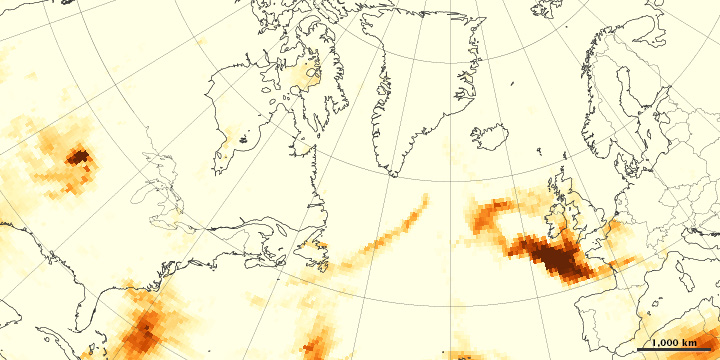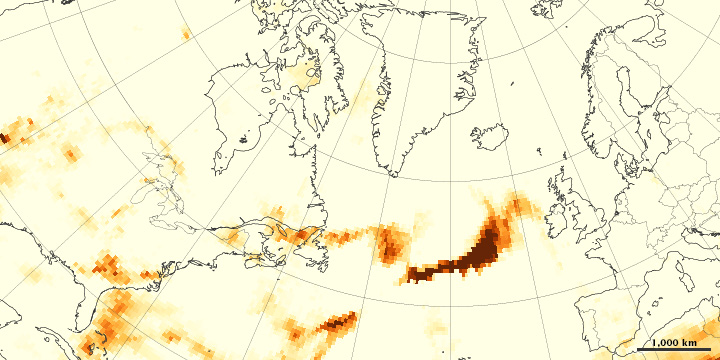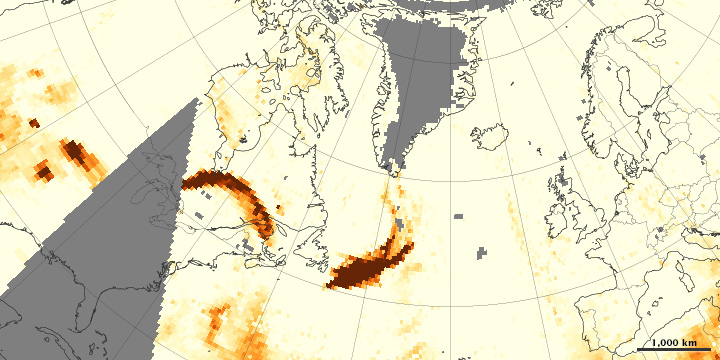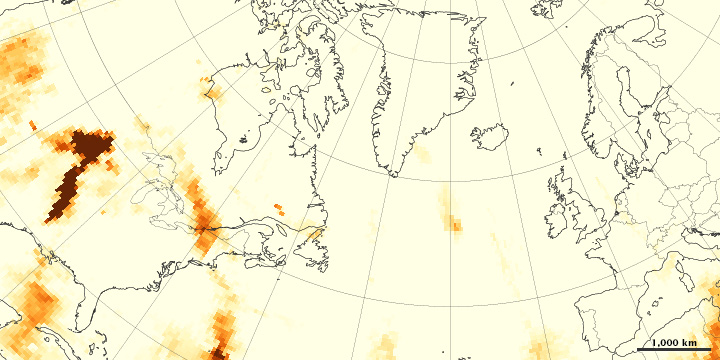
acquired June 25, 2013

acquired June 24, 2013

acquired June 23, 2013
Intense wildfires in Quebec sent smoke billowing out of Canada at the end of June 2013. The fires produced towering pyrocumulus clouds that injected smoke high into the atmosphere. Upper-level winds then dispersed it across the Atlantic Ocean.
Wildfire smoke is a combination of gases and aerosols—tiny
solid and liquid particles suspended in air—so remote-sensing
instruments that detect aerosols can find smoke. The maps above are made
from data collected by the Ozone Mapper Profiler Suite (OMPS) on the Suomi National Polar-orbiting Partnership
(Suomi-NPP) satellite. They show relative aerosol concentrations, with
lower concentrations appearing in yellow and higher concentrations
appearing in dark orange-brown. Areas in gray represent data that was
not available.
On June 23, 2013, OMPS detected a plume dense with smoky aerosols
over the North Atlantic Ocean, east of Newfoundland. The plume blew east
on the 24th and reached France by June 25. While wildfires in Colorado may have contributed to the plume (notice the heavy smoke over Colorado on June 22), a trajectory analysis
by Alain Malo, a meteorologist from the Meteorological Service of
Canada, suggests that much of the smoke actually came from Quebec.
The ambiguity explains why remote sensing scientists rarely use just
one sensor to analyze smoke transport events like this. It is common for
plumes of wildfire smoke to cross the Atlantic, and scientist use
several satellite sensors to observe the process. But each sensor has
strengths and weaknesses, explained Hongbin Yu, a University of Maryland
scientist who recently authored an analysis of satellite observations of aerosol transport events between continents.
OMPS measurements can be affected by the height of the plume and by
the brightness of underlying clouds; OMPS sees higher plumes more
readily than lower plumes, and bright underlying clouds can cause
aerosol values to be appear artificially high. Because they offer a
“semi-quantitative” measure of aerosol loading OMPS’s aerosol
measurements can sometimes be difficult to interpret.
On the other hand, “unlike MODIS and MISR,
OMPS is not limited to cloud-free conditions, so it provides more
complete plume tracking,” Yu explained. The most comprehensive approach
to monitoring intercontinental smoke transport is to use MISR to observe
smoke injection height near source fires, OMPS to track plumes over
long distances, MODIS to measure aerosol loading, and CALIOP to capture a vertical profiles of smoke plumes.
References
- Yu, H. et al (2013, April 28) Satellite perspective of aerosol intercontinental transport: From qualitative tracking to quantitative characterization. Atmospheric Research, (124), 73-100.
- NASA OMPS blog (2013, June 26) Smoke Reaches France. Accessed July 1, 2013.
- NASA OMPS blog (2013, June 25) Smoke Travels Across the Atlantic. Accessed July 1, 2013.
- UMBC U.S. Air Quality Smog Blog (2013, June 23) Weekend edition: Major Pyrocumulus Blow Up in Colorado. Accessed June 23, 2013.
NASA Earth Observatory
images by Jesse Allen, using OMPS research data provided courtesy of
Colin Seftor (SSAI) and NASA’s Suomi NPP Ozone Science Team. Caption by
Adam Voiland.
- Instrument:
- Suomi NPP - OMPS
NASA: Fires - Wildfires Smoke Crosses the Atlantic - 09.07.13
Ricardo M Marcenaro - Facebook
Blogs in operation of The Solitary Dog:
Solitary Dog Sculptor:
http://byricardomarcenaro.blogspot.com
Solitary Dog Sculptor I:
http://byricardomarcenaroi.blogspot.com
Para:
comunicarse conmigo,
enviar materiales para publicar,
propuestas comerciales:
marcenaroescultor@gmail.com
For:
contact me,
submit materials for publication,
commercial proposals:
marcenaroescultor@gmail.com
My blogs are an open house to all cultures, religions and countries. Be a follower if you like it, with this action you are building a new culture of tolerance, open mind and heart for peace, love and human respect.
Thanks :)
Mis blogs son una casa abierta a todas las culturas, religiones y países. Se un seguidor si quieres, con esta acción usted está construyendo una nueva cultura de la tolerancia, la mente y el corazón abiertos para la paz, el amor y el respeto humano.
Gracias :)
ecc


No hay comentarios:
Publicar un comentario